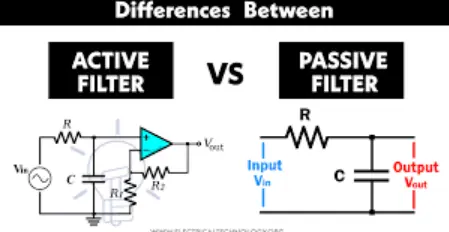Difference Between Active And Passive Filters
Active and passive filters difference can be defined as Active filters are filters that use an external power source to operate and can provide amplification and greater design and configuration flexibility. Passive filters, on the other hand, do not use an external power supply and cannot provide amplification.

Passive filters rely on components such as resistors, capacitors and inductors to filter the signal and are larger and heavier than active filters.
What is an Active Filter?
Active filters are circuits that use active electronic components such as operational amplifiers or transistors to filter audio or voltage signals.
These filters can be used to attenuate or remove specific frequencies from the input signal, allowing only the desired frequencies to pass through the circuit.
Active filters are available in various cutoff and attenuation characteristics and can be used for applications such as audio processing, sensor noise removal, and EMI suppression.
Active filters have a number of advantages over passive filters. For example, they may provide greater gain, be smaller and lighter, and may have a more flexible design and fit.
However, they also require external power to operate and can have greater distortion and signal loss than passive filters.
What is an Passive Filter?
Passive filters are circuits that use passive electronic components such as resistors, capacitors and inductors to filter audio or voltage signals.
These filters can be used to attenuate or remove specific frequencies from the input signal, allowing only the desired frequencies to pass through the circuit.
Passive filters are available in a variety of cutoff and attenuation characteristics and can be used for applications such as audio processing, sensor noise removal, and EMI suppression.
Passive filters have some advantages over active filters. For example, they don’t require an external power source to operate and are often easier and cheaper to manufacture.
However, they cannot provide amplification and are often larger and heavier due to the need for high inductance or capacitance components.
Additionally, passive filters can have greater signal loss and distortion than active filters due to the inherent impedance of the components they use.
Key Differences Between Active And Passive Filters in Tabular Form
| Characteristic | Active filters | Passive filters |
| Power supply | Yes | Not |
| Revenue | Yes | Not |
| Size and weight | Smaller and lighter | bigger and heavier |
| Distortion and signal loss | Minor | Elderly |
| Flexibility in terms of design and fit | Elderly | Minor |
Active Filters Vs Passive Filters (comparison)
Power Source
- The active filter requires an external power supply. While, The passive crossover requires no external power.
Gain
- The active filter provides high power gain and amplifies the output signal.
- Passive crossover does not increase horsepower. In fact, the output signal has a smaller amplitude than the input signal.
Design
- The active filter has a complex design. The passive filter has a simple design.
Loading Effect
- An active filter does not have the loading effect problem because it has a low output signal and a high input impedance. While passive filters has a problem with the reload effect.
Bandwidth
- Active filters are frequency limited and cannot filter high frequency signals due to the limited bandwidth of the active components. on the contrary, passive filter has no frequency limits.
Size
- Active filters are compact, with reduced dimensions and weight.
- Passive filters are bulkier due to the size of the inductor and are heavy, especially at low frequencies which require large inductors.
Cost
- Active filters are expensive and expensive due to the active components and power requirements.
- Passive filters are made with inexpensive passive components.
Related Topics in Electronic Devices Physics
- What is Electricity? Definition, Facts, Types And Importance in Physics
- What is Altitude? Definition, Meaning and Measurement With Examples
- What is thermodynamics? Definition, Equations, Laws
- Electric current: Definition, symbol, formula, Unit & Types
- What is optics? Basic Laws of Optics and definition in Physics
